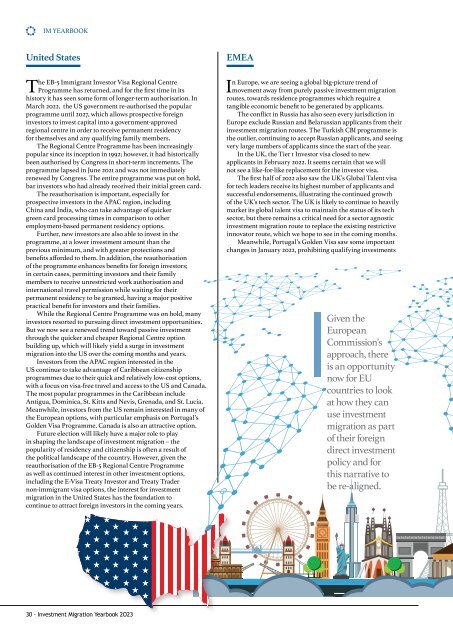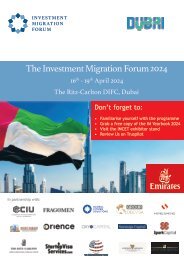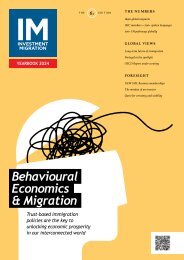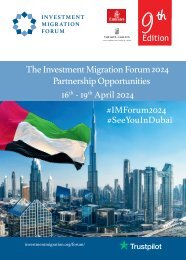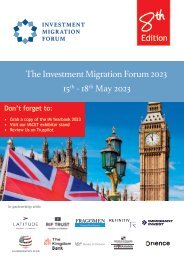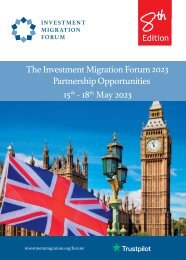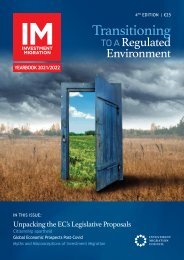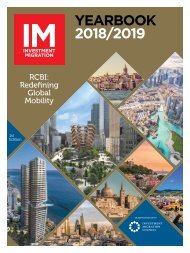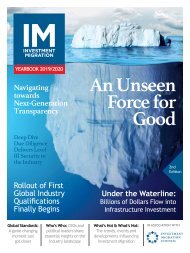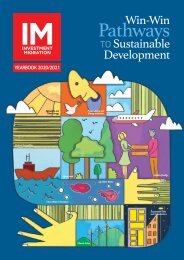IM Yearbook 2023
The completely new IM Yearbook 2023 is the 5th edition of what is now known as the most anticipated guide of the Investment Migration industry. The IM Yearbook is the essential global reference tool for the industry by the industry. Offering unrivaled valuable access to a prime targeted readership of your partners, clients and potential new business сontacts. Decision-makers in more than 54 countries trust the publication as a reputable source of information and guide. Readership includes: agents, law firms, advisory firms, banks, wealth managers, service providers, policy makers, government staffers, international organisations, and academics. Providing comprehensive, in-depth information about the global Investment Migration industry, the IM Yearbook 2023 will offer readers a practical A-Z guide to the current business operating environment while also highlighting the depth and breadth of practitioners, programmes, and their partners of all types.
The completely new IM Yearbook 2023 is the 5th edition of what is now known as the most anticipated guide of the Investment Migration industry.
The IM Yearbook is the essential global reference tool for the industry by the industry. Offering unrivaled valuable access to a prime targeted readership of your partners, clients and potential new business сontacts. Decision-makers in more than 54 countries trust the publication as a reputable source of information and guide. Readership includes: agents, law firms, advisory firms, banks, wealth managers, service providers, policy makers, government staffers, international organisations, and academics.
Providing comprehensive, in-depth information about the global Investment Migration industry, the IM Yearbook 2023 will offer readers a practical A-Z guide to the current business operating environment while also highlighting the depth and breadth of practitioners, programmes, and their partners of all types.
You also want an ePaper? Increase the reach of your titles
YUMPU automatically turns print PDFs into web optimized ePapers that Google loves.
<strong>IM</strong> YEARBOOK<br />
United States<br />
The EB-5 Immigrant Investor Visa Regional Centre<br />
Programme has returned, and for the first time in its<br />
history it has seen some form of longer-term authorisation. In<br />
March 2022, the US government re-authorised the popular<br />
programme until 2027, which allows prospective foreign<br />
investors to invest capital into a government-approved<br />
regional centre in order to receive permanent residency<br />
for themselves and any qualifying family members.<br />
The Regional Centre Programme has been increasingly<br />
popular since its inception in 1992; however, it had historically<br />
been authorised by Congress in short-term increments. The<br />
programme lapsed in June 2021 and was not immediately<br />
renewed by Congress. The entire programme was put on hold,<br />
bar investors who had already received their initial green card.<br />
The reauthorisation is important, especially for<br />
prospective investors in the APAC region, including<br />
China and India, who can take advantage of quicker<br />
green card processing times in comparison to other<br />
employment-based permanent residency options.<br />
Further, new investors are also able to invest in the<br />
programme, at a lower investment amount than the<br />
previous minimum, and with greater protections and<br />
benefits afforded to them. In addition, the reauthorisation<br />
of the programme enhances benefits for foreign investors;<br />
in certain cases, permitting investors and their family<br />
members to receive unrestricted work authorisation and<br />
international travel permission while waiting for their<br />
permanent residency to be granted, having a major positive<br />
practical benefit for investors and their families.<br />
While the Regional Centre Programme was on hold, many<br />
investors resorted to pursuing direct investment opportunities.<br />
But we now see a renewed trend toward passive investment<br />
through the quicker and cheaper Regional Centre option<br />
building up, which will likely yield a surge in investment<br />
migration into the US over the coming months and years.<br />
Investors from the APAC region interested in the<br />
US continue to take advantage of Caribbean citizenship<br />
programmes due to their quick and relatively low-cost options,<br />
with a focus on visa-free travel and access to the US and Canada.<br />
The most popular programmes in the Caribbean include<br />
Antigua, Dominica, St. Kitts and Nevis, Grenada, and St. Lucia.<br />
Meanwhile, investors from the US remain interested in many of<br />
the European options, with particular emphasis on Portugal’s<br />
Golden Visa Programme. Canada is also an attractive option.<br />
Future election will likely have a major role to play<br />
in shaping the landscape of investment migration – the<br />
popularity of residency and citizenship is often a result of<br />
the political landscape of the country. However, given the<br />
reauthorisation of the EB-5 Regional Centre Programme<br />
as well as continued interest in other investment options,<br />
including the E-Visa Treaty Investor and Treaty Trader<br />
non-immigrant visa options, the interest for investment<br />
migration in the United States has the foundation to<br />
continue to attract foreign investors in the coming years.<br />
EMEA<br />
In Europe, we are seeing a global big-picture trend of<br />
movement away from purely passive investment migration<br />
routes, towards residence programmes which require a<br />
tangible economic benefit to be generated by applicants.<br />
The conflict in Russia has also seen every jurisdiction in<br />
Europe exclude Russian and Belarussian applicants from their<br />
investment migration routes. The Turkish CBI programme is<br />
the outlier, continuing to accept Russian applicants, and seeing<br />
very large numbers of applicants since the start of the year.<br />
In the UK, the Tier 1 Investor visa closed to new<br />
applicants in February 2022. It seems certain that we will<br />
not see a like-for-like replacement for the investor visa.<br />
The first half of 2022 also saw the UK’s Global Talent visa<br />
for tech leaders receive its highest number of applicants and<br />
successful endorsements, illustrating the continued growth<br />
of the UK’s tech sector. The UK is likely to continue to heavily<br />
market its global talent visa to maintain the status of its tech<br />
sector, but there remains a critical need for a sector agnostic<br />
investment migration route to replace the existing restrictive<br />
innovator route, which we hope to see in the coming months.<br />
Meanwhile, Portugal’s Golden Visa saw some important<br />
changes in January 2022, prohibiting qualifying investments<br />
Given the<br />
European<br />
Commission’s<br />
approach, there<br />
is an opportunity<br />
now for EU<br />
countries to look<br />
at how they can<br />
use investment<br />
migration as part<br />
of their foreign<br />
direct investment<br />
policy and for<br />
this narrative to<br />
be re-aligned.<br />
30 - Investment Migration <strong>Yearbook</strong> 2O23


